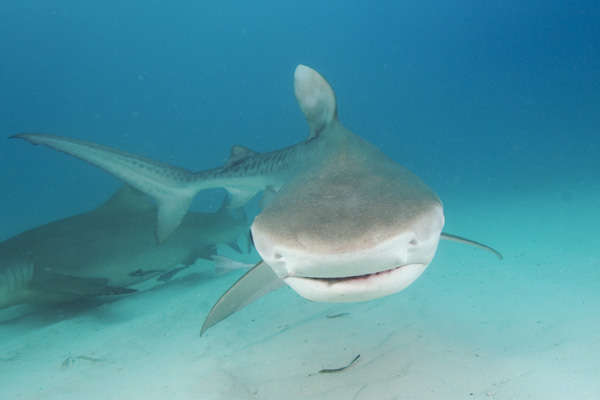
The tiger shark, Galeocerdo cuvier, one of the largest sharks, is the only member of the genus Galeocerdo. Mature sharks average 3.25 metres (11 ft) to 4.25 metres (14 ft)[3] [4] and weigh 385 to 909 kg (850 to 2000 lb).[5] It is found in many of the tropical and temperate regions of the world's oceans, and is especially common around islands in the central Pacific. This shark is a solitary hunter, usually hunting at night. Its name is derived from the dark stripes down its body, which fade as the shark matures.
The tiger shark is a dangerous predator, known for eating a wide range of items. Its usual diet consists of fish, seals, birds, smaller sharks, squid, and turtles. It has sometimes been found with man-made waste such as license plates or pieces of old tires in its digestive tract. It is notorious for attacks on swimmers, divers and surfers in Hawaii; and is often referred to as the "bane of Hawaiian surfers"[6] and "the wastebasket of the sea".
The tiger shark is second only to the bull shark in number of recorded human fatalities [3] and is considered, along with the great white, bull shark, and the oceanic whitetip shark to be one of the sharks most dangerous to humans. [7] Tiger Sharks are most commonly found in Peru on the coast of Punta Sal. Tiger sharks migrate yearly to the warmer waters of Punta Sal, Peru during the months of January thru to March for feeding and mating.
Although shark attacks on humans are a relatively rare phenomenon, the tiger shark is responsible for a large percentage of the fatal attacks that do occur on humans, and is regarded as one of the most dangerous species of sharks. Tiger sharks reside in temperate and tropical waters. They are often found in river estuaries and harbours, as well as shallow water close to shore, where they are bound to come into contact with humans. Because of their curious nature of feeding it is expected that a tiger shark would normally attack a human if it came in contact with it. Tiger sharks are known to dwell in waters with runoff, such as where a river enters the ocean.
Tiger sharks have become a recurring problem in Hawaii and are considered the most dangerous shark species in Hawaiian waters. They are considered to be sacred 'aumakua' or ancestor spirits by the native Hawaiians, however between 1959 and 1976, 4,668 tiger sharks were hunted down in an effort to control what was proving to be detrimental to the tourism industry. Despite these numbers, little decrease was ever detected in the attacks on humans. It is illegal to feed sharks in Hawaii and any interaction with them such as cage diving is discouraged.[11]
While the tiger shark is not directly commercially fished, it is caught for its fins, flesh, liver, which is a valuable source of vitamin A used in the production of vitamin oils, and distinct skin, as well as by big game fishers.[3]
Tiger shark's fins are known as sea tiger fins (traditional Chinese:海虎翅) in Chinese cuisine. It is used for making shark fin soup and is very popular among the affluent in China.













